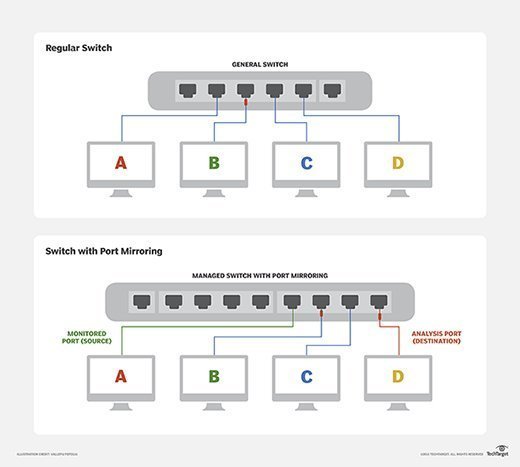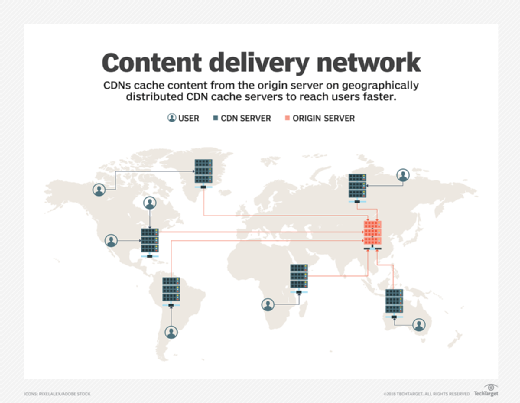mirror site
What is a mirror site?
A mirror site is a website or set of files on a computer server that has been copied to another computer server so that the site or files are available from more than one place. A mirror site has its own URL but is otherwise identical to the principal site.
Load-balancing devices enable high-volume sites to scale easily, dividing the work between multiple mirror sites. During mirroring, data is pushed out to the mirror facility, where it is available when needed. Replication is another term for mirroring.
How a mirror site works
A mirror site, such as a mirrored website, is usually updated frequently to ensure it reflects the contents of the original site. In some cases, the original site arranges for a mirror site at a larger location with a higher-speed connection and, perhaps, a closer proximity to a large audience.
If the original site generates too much traffic, a mirror site can ensure better availability of the website or files. For websites that offer copies or updates of widely used software, a mirror site lets the site handle larger demands and enables the downloaded files to arrive faster. Microsoft and other companies have mirror sites from which their browser software can be downloaded.
Mirror sites are used to make site access faster when the original site may be geographically distant from those accessing it. A mirrored web server is often located on a different continent from the principal site, letting users close to the mirror site get faster and more reliable access.
Applications for mirroring
Mirroring is primarily associated with making an exact copy of specific information resources. Examples of how mirroring is used include the following:
- High availability. An important way to protect a website is to mirror it in a secure facility located at a distance from the facility where the original website is hosted. This ensures the site is continuously available. The primary and mirrored sites support duplicate content; if the primary site fails or undergoes maintenance, the mirrored site is brought into operation. Mirrored sites are used to store software patches and revisions and provide relief for main servers during periods of high demand.
- Redundancy. Being able to mirror IT resources increases redundancy and availability, especially when primary IT assets are disrupted or damaged. This reduces the likelihood of a system disruption that could threaten the organization.
- Global accessibility. If sufficient bandwidth for network traffic is available, mirrored sites can reduce latency, making them advantageous for an organization with geographically distributed customers. Closer proximity to the mirrored site can speed up downloads for remote customers.
- Disaster recovery (DR). Mirrored systems, websites and data are essential in DR situations. The mirrored site has an exact copy of the primary asset and can be brought into service if the primary system fails or is corrupted. Optimization of these systems ensures mirroring occurs whenever something new is created or existing items are changed.
- Data protection. Mirrored sites can store exact copies of critical documents, such as legal contracts, and historical documents, such as copies of articles of incorporation. They provide a secure location for webpages to function when the primary system is shut down or is being modified.
- Censorship safeguard. Mirrored sites can protect data subject to government censorship and facilitate restoration when that becomes feasible.
- Freedom of information. Mirroring data on secure resources can enhance freedom of information. It can also help ensure information is available when requested.
- Testing and development. During development, copies of a website at various stages can be mirrored at a secure location for review, retrieval, testing and modification when needed, while the primary version remains protected.
What is port mirroring?
Port mirroring enables network administrators to analyze data, monitor traffic loads and diagnose network problems. By placing a protocol analyzer on a port, administrators can track switch performance.

When port mirroring is enabled, a switch sends copies of all network packets from one port to another to be analyzed. Different switch manufacturers have their own names for port mirroring, such as Cisco's Switched Port Analyzer.
Content delivery network and mirroring
Mirroring can be considered a static form of content delivery. Similar to a mirror site, a content delivery network (CDN) exists as multiple copies on servers in different locations. Like a mirror site, a CDN enables easier access to content from geographically diverse locations.
Even when bandwidth is limited, a CDN can meet high-bandwidth requests, such as delivering streaming audio and video content. A CDN caches content from the original site, so it isn't an exact replica of the original site.

Pros and cons of mirroring
Mirroring helps ensure high availability and redundancy of critical IT resources. It supports load balancing, which improves access and reduces latency. It also facilitates DR activities and makes resources available in geographically distributed applications.
The drawbacks of mirroring include the costs associated with the added hardware, network services and operational elements that mirrored sites require. An organization must define the need for mirroring carefully to secure approval for it from senior management. Mirroring also has technology challenges, such as the need to synchronize the primary and mirror sites, which may create difficulties for users who need real-time data access.
Building a mirror site
The steps required when mirroring systems, data or databases are the following:
- Identify the assets to be mirrored.
- Obtain mirroring software if exact copies are required.
- Set up a storage medium, preferably in a different physical location from the original asset, to ensure availability and recoverability.
- Copy the assets to be mirrored to the alternate storage facility.
- Check the mirrored assets to ensure they're present in the alternate location.
- Establish an ongoing process for mirroring the asset.
Mirroring a website is a somewhat different process. It starts with downloading all files and elements associated with the site. These can include JavaScript files, images and Hypertext Markup Language code. Then, a hosting service must be chosen to run the mirrored website.
Mirrored sites and data repositories can be located in many different places, including a primary data center or an alternate company data center. They can also be located in a cloud service provider's or managed service provider's facility. CSPs and MSPs can often support geographically distributed mirror sites.
Additional sources of mirroring services include commercial and open source software developers, CDNs, academic and research institutions, government agencies and nonprofit organizations.
Future of mirroring
Considering how important it is to protect systems, data, websites and other information resources, mirroring is likely to remain a popular solution. Downstream applications that mirroring is likely to benefit include blockchain, edge computing, internet of things and content developed using artificial intelligence (AI).
Learn more about some of the technologies that are likely to use mirroring capabilities in the future, such as edge computing and AI.







